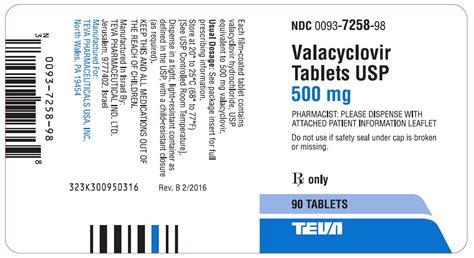Intro
Discover common Valacyclovir side effects, including nausea, headaches, and fatigue. Learn about dosage, interactions, and managing symptoms of this antiviral medication.
Valacyclovir, a medication used to treat viral infections such as herpes simplex and herpes zoster, has been a crucial component in the management of these conditions. Its effectiveness in reducing the severity and duration of symptoms has made it a widely prescribed medication. However, like all medications, valacyclovir can cause side effects, some of which can be severe. Understanding these side effects is essential for patients to make informed decisions about their treatment and for healthcare providers to monitor and manage potential adverse reactions effectively.
The importance of recognizing valacyclovir side effects cannot be overstated. While many patients may experience mild or no side effects at all, others may encounter more serious issues that can impact their quality of life. By being aware of the potential side effects, patients can take proactive steps to minimize their risk and seek medical attention if necessary. Furthermore, the management of side effects is a critical aspect of ensuring that patients adhere to their treatment regimens, which is vital for the effective control of viral infections.
Valacyclovir's mechanism of action involves the inhibition of viral DNA synthesis, thereby reducing the replication of the virus. This targeted approach has made valacyclovir a preferred treatment option for many patients. However, the interaction of valacyclovir with the body's biological systems can sometimes lead to unwanted effects. These side effects can range from common, mild issues such as headache and nausea to more severe, albeit rare, conditions like renal impairment and neurological effects. The diversity of potential side effects underscores the need for comprehensive patient education and monitoring.
Common Side Effects of Valacyclovir

Common side effects of valacyclovir are typically mild and may include headache, nausea, vomiting, and diarrhea. These symptoms are often transient and may resolve on their own without the need for medical intervention. However, if they persist or worsen, patients should consult their healthcare provider for guidance. Other common side effects can include abdominal pain, dizziness, and fatigue. It's essential for patients to understand that while these side effects can be uncomfortable, they are generally not serious and do not necessitate discontinuation of the medication.
Less Common but Significant Side Effects
Less common side effects of valacyclovir can be more significant and may require medical attention. These include renal impairment, which can be a concern for patients with pre-existing kidney disease, and neurological effects such as confusion, agitation, and hallucinations. The occurrence of these side effects underscores the importance of careful patient selection and monitoring, particularly in vulnerable populations such as the elderly and those with underlying health conditions.Severe Side Effects of Valacyclovir

Severe side effects of valacyclovir, although rare, can be life-threatening and require immediate medical attention. These include anaphylaxis, a severe allergic reaction that can cause difficulty breathing, rapid heartbeat, and a fall in blood pressure, and thrombotic thrombocytopenic purpura/hemolytic-uremic syndrome (TTP/HUS), a condition characterized by the formation of blood clots in small blood vessels throughout the body. The risk of these severe side effects highlights the need for vigilant monitoring and prompt reporting of any unusual symptoms to healthcare providers.
Managing Valacyclovir Side Effects
The management of valacyclovir side effects involves a combination of patient education, monitoring, and, when necessary, medical intervention. Patients should be advised to report any side effects to their healthcare provider, who can then assess the severity of the effects and determine the best course of action. This may involve adjusting the dose of valacyclovir, switching to an alternative medication, or providing treatment for the side effect itself. In some cases, patients may need to be hospitalized for close monitoring and management, particularly if they are experiencing severe side effects.Prevention of Valacyclovir Side Effects

Preventing valacyclovir side effects begins with careful patient selection and assessment of the risk-benefit ratio of treatment. Healthcare providers should thoroughly evaluate patients' medical histories, including any pre-existing conditions or allergies, and adjust treatment plans accordingly. Patients should also be educated on the proper use of valacyclovir, including the importance of adhering to the prescribed dosage and schedule, and the need to report any side effects promptly. Additionally, regular monitoring of kidney function and blood counts can help identify potential issues early, allowing for timely intervention.
Special Considerations
Special considerations are necessary when prescribing valacyclovir to certain populations, including the elderly, pregnant women, and individuals with compromised immune systems. These groups may be at increased risk of side effects due to age-related changes, the potential for drug interactions, or the underlying condition being treated. Healthcare providers must carefully weigh the benefits of valacyclovir against the potential risks and consider alternative treatment options when necessary.Conclusion and Future Directions

In conclusion, while valacyclovir is an effective treatment for viral infections, its potential side effects must be acknowledged and managed. By understanding the common, less common, and severe side effects associated with valacyclovir, healthcare providers can better counsel patients and make informed decisions about treatment. Future research should continue to explore strategies for minimizing side effects and improving treatment outcomes for patients with viral infections.
Final Thoughts
As patients and healthcare providers navigate the complexities of valacyclovir treatment, it's essential to maintain open communication and vigilance. By working together, we can ensure that the benefits of valacyclovir are maximized while its risks are minimized. Whether through patient education, careful monitoring, or the development of new treatment strategies, our collective goal should be to provide the best possible care for those affected by viral infections.
We invite you to share your thoughts and experiences with valacyclovir in the comments below. Your insights can help others better understand the treatment and its implications. If you found this article informative, please consider sharing it with others who might benefit from this information. Together, we can foster a community of support and knowledge, working towards better health outcomes for all.
What are the most common side effects of valacyclovir?
+The most common side effects of valacyclovir include headache, nausea, vomiting, and diarrhea. These symptoms are usually mild and temporary.
Can valacyclovir cause severe side effects?
+Yes, although rare, valacyclovir can cause severe side effects such as anaphylaxis and thrombotic thrombocytopenic purpura/hemolytic-uremic syndrome (TTP/HUS). These conditions require immediate medical attention.
How can I minimize the risk of valacyclovir side effects?
+To minimize the risk of side effects, it's crucial to follow the prescribed dosage, report any side effects to your healthcare provider promptly, and undergo regular monitoring as advised.
